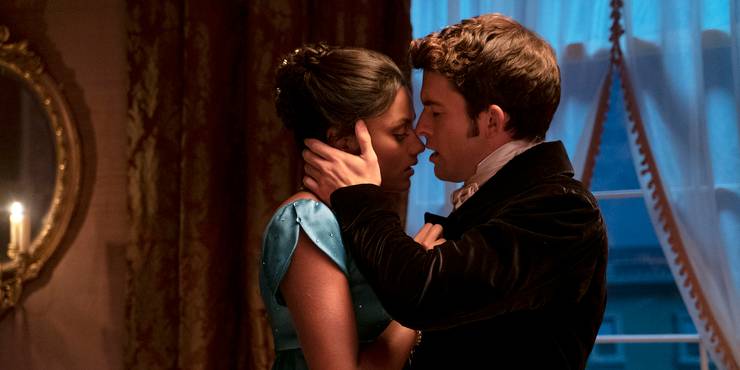Bridgerton Season 2’s Hardest Sex Scene To Film Revealed By Intimacy Coordinator

The intimacy coordinator for the Netflix show Bridgerton reveals which was the most difficult sex scene to film. Bridgerton, based on the book series by Julia Quinn, explores the nature of courtship and debutantes in Regency-era London, featuring gorgeously detailed costumes, witty writing, nuanced characters, and—perhaps most conversed about—incredibly steamy and romantic sex scenes. Bridgerton season 1, which premiered on Netflix in late 2020, focuses on the courtship between Daphne Bridgerton (Phoebe Dynevor) and Duke Simon Bassett (Regé-Jean Page); the second season, which premiered last week, focuses on Daphne’s brother, Anthony (Jonathon Bailey), and his courtship with Kathani (Simone Ashley).
Bridgerton has been lauded for its focus on female pleasure, which importantly renders the show much more accessible to woman who account for much of Netflix’s viewership and therefore contributed to the show’s widespread success. However, spectators found that the lack of sex scenes in Bridgerton season 2 rendered the show a little too accessible in an attempt to be “family-friendly” and target even more people and, thus, felt watered down. Others, in comparison, enjoyed the implicit nature of the sex appeal and contended that it actually heightened the sexual energy of the season with its heavy use of subtext—furthermore, the sex scenes that the second season does contain certainly hold their own distinctive appeal.
In an interview with Glamour, Lizzy Talbot, the intimacy coordinator for the show, reveals which of these sex scenes in Bridgerton season 2 proved the most difficult to film. Talbot’s position as intimacy coordinator is a relatively new but important role on set—she works with actors in vulnerable scenes, in this case, Bailey and Ashley, to first and foremost ensure their continual comfort, but also establish an ethical, convincingly sensual, and deliberate depiction of pleasure. Talbot notably focuses on the depiction of the female gaze in Bridgerton‘s sex scenes, which means exploring the nuances of positions and angles that more traditional male-centric sex scenes previously left as frustratingly uncharted territory. The scene that proved the most tricky for Talbot to coordinate appears in episode 8, in which Anthony and Kate sit face-to-face, a position that Talbot notes proved difficult in a tiny Regency-era bed.
“There’s a scene in episode eight, right at the end, that was quite challenging because we actually had them in a face-to-face position, sitting up, which is a little complicated to do. It worked really beautifully, but that took a lot of figuring out because that angle and position on a Regency bed is really tricky.”

However, Talbot also notes that in many ways this challenge only enhanced the resulting sexuality rendered, due to the deliberation and time taken to undress and maneuver in such a unique position and environment. Indeed, Talbot corroborates that the very tension-filled nature of the relationship between Anthony and Kathani accounts for the lack of sex scenes in the second season and that the simmering, slow-building quality builds an exquisite and charged anticipation for its eventual release in scenes like this one. And clearly, this method works–Netflix recently renewed the sumptuous Bridgerton for both a season 3 and 4 following the success of the second season, illustrating that gearing a show towards women’s desires rather than solely those of men does not limit a show’s success.
Bridgerton, therefore, is doing crucial feminist work in successfully and appealingly deconstructing and subverting the assumption that only male-targeted entertainment draws box office and viewership appeal. The show also questions the very notion of why sex scenes are often so patriarchally coded and focused in the first place. Though the first season proved pleasing in its explicit nature and the second in its implicit, both maintain a refreshing and satisfying departure from traditional sex scenes that often dehumanize the woman character and only focus on the pleasure elicited by and for the male character (and thus, male spectator). The very existence of such variance of sex scenes (or lack thereof) throughout Bridgerton illustrates, in fact, most beautifully and accurately the multifaceted, detailed, and nuanced nature of woman’s pleasure and gaze itself–pleasure that, thanks to Talbot’s work and regardless of a viewer’s gender, promises to keep delivering in the seasons to come.
Source: Glamour

















